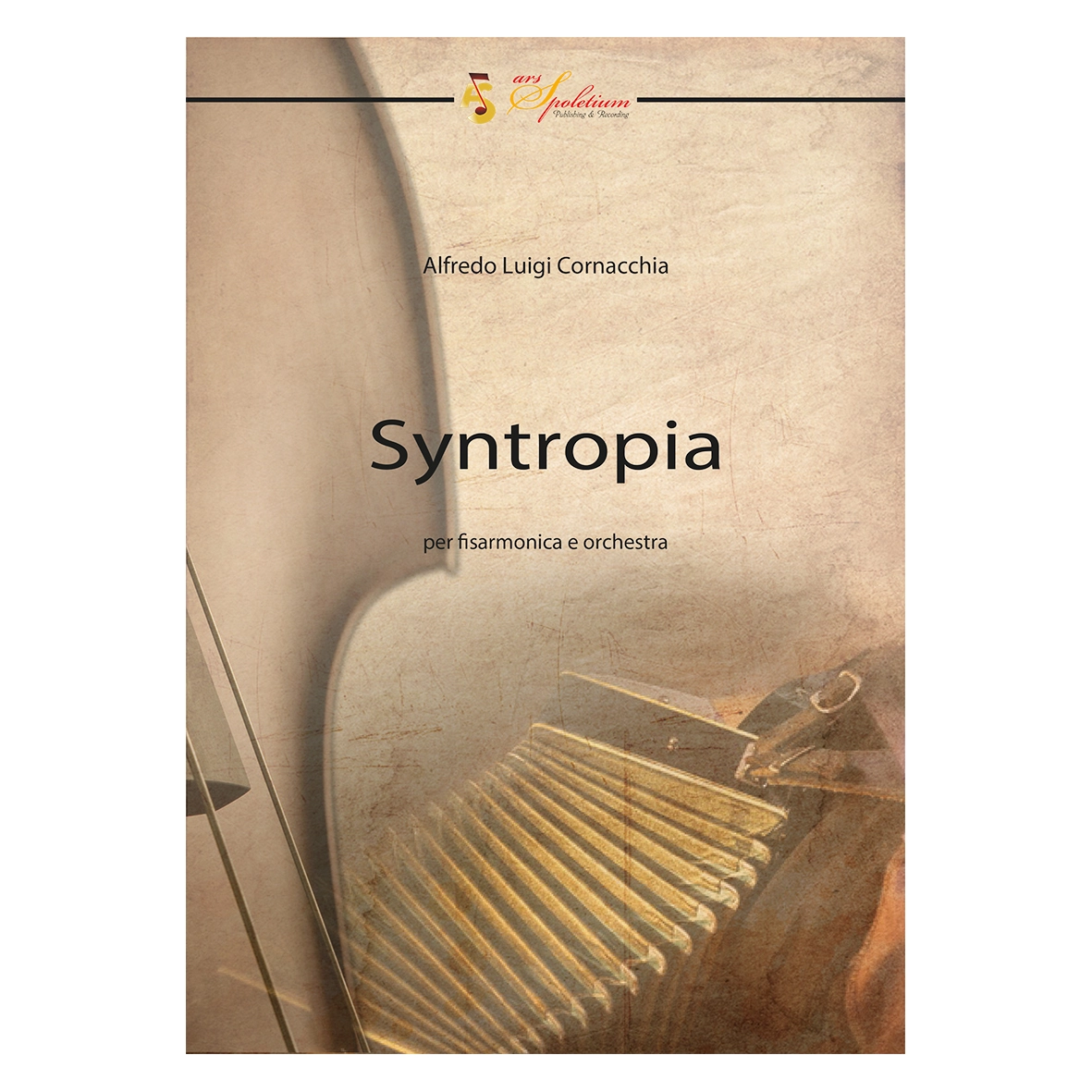Syntropia
10,00 €
Syntropia passa attraverso e supera, nello stesso tempo, il concetto di concerto e sinfonia, ponendosi in una ottica rinnovata di sinfonia concertante; di questi sopravvivono gli episodi, le alternanze agogiche che diventano gesti, caratterizzando l’intera composizione. La scrittura impegnativa del solista si colloca, così, tra la complicità e il dialogo, in una dialettica costante tra due mondi sonori.
(LA PARTITURA IN OGGETTO È DISPONIBILE SOLO NELLA VERSIONE PDF)
Syntropia passes through and surpasses the concept of concerto and symphony at the same time, placing itself in a renewed perspective of “sinfonia concertante”; the episodes of these survive, the agogic alternations that become gestures, characterizing the entire composition.
(ONLY PDF VERSION)
Syntropia passa attraverso e supera, nello stesso tempo, il concetto di concerto e sinfonia, ponendosi in una ottica rinnovata di sinfonia concertante; di questi sopravvivono gli episodi, le alternanze agogiche che diventano gesti, caratterizzando l’intera composizione. La scrittura impegnativa del solista si colloca, così, tra la complicità e il dialogo, in una dialettica costante tra due mondi sonori.
In tal senso, il concerto si può dividere in due grandi sezioni, di derivazione classica: una sviluppata introduzione lenta e un tempo veloce, in una progressiva conquista di una definizione ritmica che si fa sempre più preminente.
Un originario inizio risonante, caratterizzato da una progressiva conquista di un focus da un caos iniziale, è fortemente impregnato di armonie sospese, giocate tra percussioni e solista, che culminano in una breve sezione in cui il ribattuto è la cifra dominante (mis. 56 e segg). Segue poi una cellula dal sapore esatonale introdotta dai legni che sarà ripresa dal solista e che darà l’avvio all’Allegro successivo (mis. 92 e segg.).
Come si diceva, la progressiva conquista di un profilo ritmico sempre più evidente, trova già un segno nella sezione tribale delle percussioni della prima parte (da mis. 60) che poi si frammenterà in mille rivoli con l’alternanza di frammenti scalari e sezioni dal profilo tonale nell’Allegro (una curiosità: il tema della mis. 131 è tratto da materiale compositivo mai utilizzato di ciò che sarebbe stato un pezzo organistico, dal titolo Le vol de l’ange de la mort).
Dopo un dialogo ritmico tra solo e orchestra (in questo si può ritrovare l’elemento dialogico del solo/tutti del concerto classico), una brusca interruzione dà l’avvio ad una sezione magmatica degli archi che torna all’Adagio della prima parte (mis. 287) su una sorta di ostinato del solo (mis. 295) che, attraverso una stratificazione ed un climax culmina in un tintinnio degli strumenti a percussione (mis. 302). Una sorta di “ripresa” ci riporta al materiale precedente presentato dell’Allegro, presentato in maniera più concisa che culmina nel finale della composizione.
Lo stile del solo alterna una scrittura lirica nella prima parte (cfr. mis. 80 e segg.) ad una toccatistica nell’Allegro, coinvolgendo in un vortice di una grande improvvisazione anche l’orchestra per tutta la parte centrale (miss. 232- 253, ciò che nella sinfonia era il ponte, inteso come transizione tra sezioni) e viene ripreso nelle ultime battute, in cui le percussioni riprendono a pieno titolo la scena insieme al solista, dialogando e alternandosi ad esso nel trionfo e tripudio finale dell’omoritmia di tutta l’orchestra.
(SU RICHIESTA, DISPONIBILI LE SINGOLE PARTITURE ORCHESTRALI)
GUARDA IL VIDEO DELLA PRIMA ESECUZIONE (Teatro Astra Castelfidardo settembre 2024)
Syntropia passes through and surpasses the concept of concerto and symphony at the same time, placing itself in a renewed perspective of “sinfonia concertante”; the episodes of these survive, the agogic alternations that become gestures, characterizing the entire composition.
In this sense, the concert can be divided into two big sections, of classical derivation: a wide slow introduction and a fast tempo, in a progressive conquest of a rhythmic definition that becomes more and more prominent.
An original resonant beginning, characterized by a progressive conquest of a focus from an initial chaos, is strongly imbued with suspended harmonies, played between percussion and soloist, which culminate in a short section in which the reiterated is the dominant figure (m. 56 and following). Then follows a cell with a six-tone flavor introduced by the woodwind which will be taken up by the soloist and which will start the following Allegro (measure 92 and following).
As we said, the progressive conquest of an increasingly evident rhythmic profile already finds a sign in the tribal percussion section of the first part (from measure 60) which will then fragment into a thousand streams with the alternation of scalar fragments and profile sections tonal in the Allegro (a curiosity: the theme of measure 131 is taken from never-used compositional material of what would have been an organ piece, entitled Le vol de l’ange de la mort).
After a rhythmic dialogue between solo and orchestra (in this we can find the dialogic element of the solo/tutti of the classical concert), an abrupt interruption gives rise to a magmatic section of the strings which returns to the Adagio of the first part (mis . 287) on a sort of solo ostinato (m. 295) which, through stratification and a climax, culminates in a tinkling of the percussion instruments (m. 302). A sort of “reprise” takes us back to the previous material presented in the Allegro, presented in a more concise manner which culminates in the finale of the composition.
The style of the solo alternates a lyrical writing in the first part (see m. 80 and following) with a toccata in the Allegro, also involving the orchestra in a vortex of great improvisation for the entire central part (m. 232- 253, what in the symphony was the bridge, understood as a transition between sections) and is taken up again in the last bars, in which the percussions fully take over the scene together with the soloist, dialoguing and alternating with him in the final triumph and jubilation of the homorhythm of the whole orchestra.
(ON DEMAND, INDIVIDUAL ORCHESTRA SCORES AVAILABLE)
WATCH THE VIDEO OF THE FIRST PERFORMANCE (Teatro Astra Castelfidardo September 2024)




